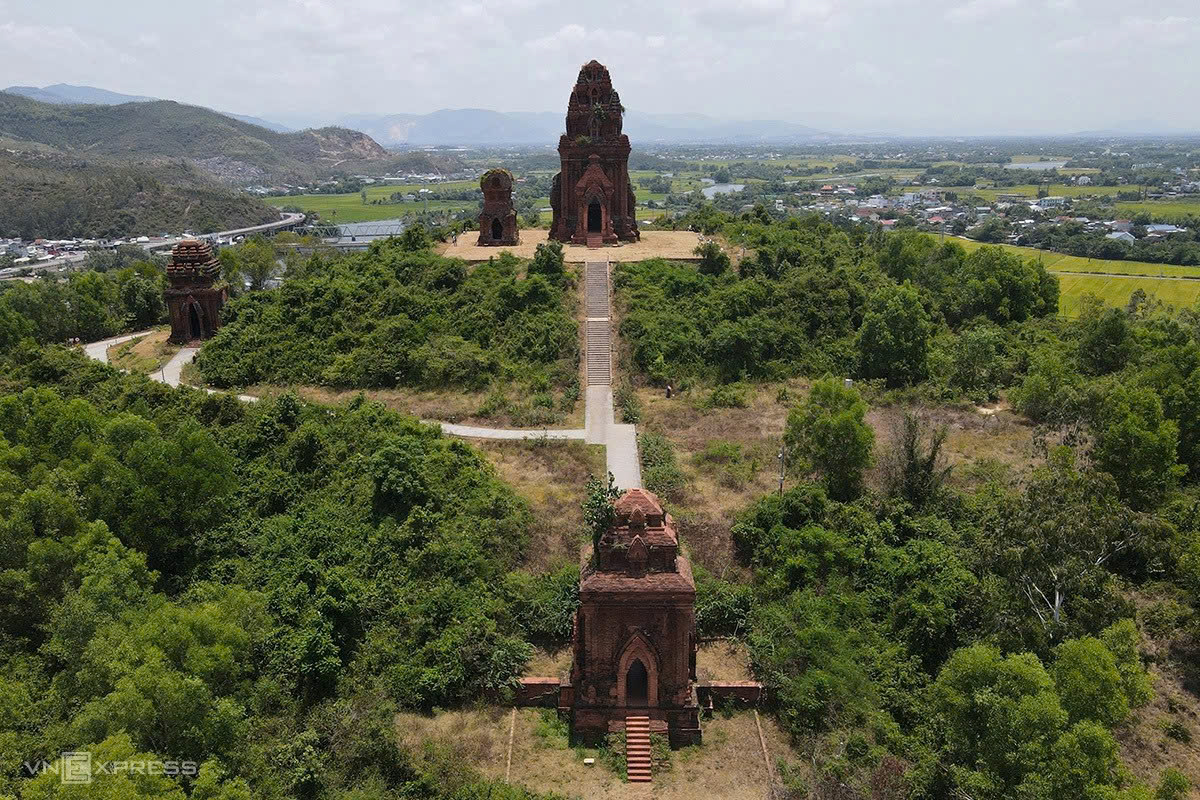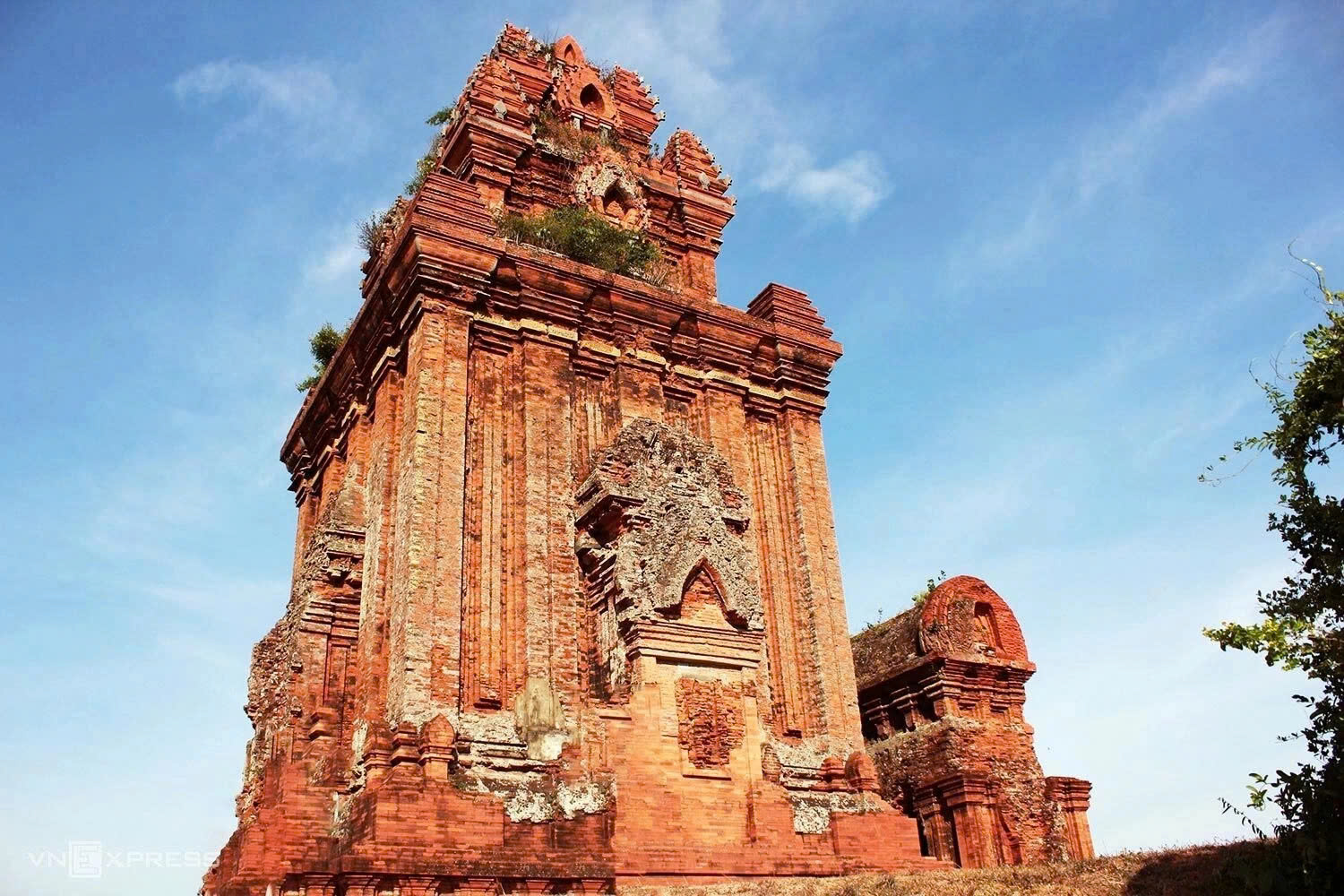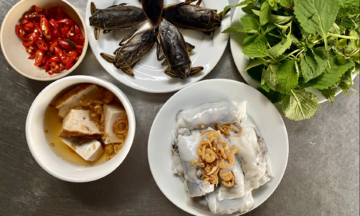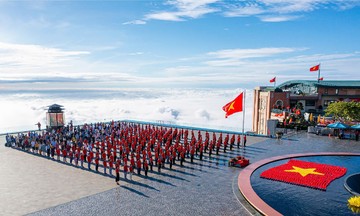The Banh It Tower complex, also known as Silver Towers, is located approximately 20 km from Quy Nhon city center. It sits atop a 100 m hill in Dai Le village, Tuy Phuoc Bac commune, nestled between two branches of the Kon River.
 |
The Banh It Tower complex perched on a hilltop in Tuy Phuoc Bac commune. Photo: Tran Hoa |
Constructed between the late 11th and early 12th centuries, the complex comprises four main towers: the Main Tower (Kalan), the Gate Tower (Gopura), the Fire Tower (Kosagrha), and the Stele Tower (Posah). It once served as a significant religious center for the ancient Vijaya region. Viewed from afar, the complex resembles "banh it," a local delicacy, which is how it earned its name. Each tower boasts a unique architectural style and function.
In 1909, French scholar Henri Parmentier lauded the artistic value of Banh It Towers within the context of Champa's cultural history. In 1982, the tower complex was recognized as a National Architectural and Artistic Relic. In 2014, the Vietnam Records Organization listed it among the top 10 most visited ancient towers. Notably, in 2015, Banh It Towers was the only Vietnamese representative featured in "1001 Buildings You Must See Before You Die," published by Quintessence (UK).
According to Dr. Phu Van Han, former Deputy Director of the Institute of Social Sciences in the Southern Region, Vietnam Academy of Social Sciences, Banh It Towers was dedicated to Hindu deities like Shiva, Vishnu, and Ganesha, incorporating elements of Cham and indigenous folk beliefs.
"Banh It Towers not only connected with other ancient Cham tower complexes in Gia Lai but also linked with the tower system in central and southern Vietnam throughout the history of the Champa kingdom," Dr. Han said.
 |
The Main Tower within the Banh It complex. Photo: Huynh Hoang Huy |
The thousand-year-old complex spans over 7,000 m2. It has the largest number of towers and the greatest scale among the eight remaining ancient Champa tower clusters in the former Binh Dinh province. Constructed from sandstone, granite, and brick, the towers face east.
The Main Tower (Kalan), situated at the hill's highest point, stands 29.6 m tall. It has a square base with 12 m sides, featuring one main entrance facing east and three false doors. The main entrance projects 2 m outward, with a lancet arch and a Kala relief, a protective deity, at its center. The roof cornice depicts the monkey god Hanuman dancing, while the false doors are adorned with Gajasimha (elephant-lion) reliefs. Inside sits a replica of the Shiva statue, the original being housed at the Guimet Museum in France. According to *Asian Art* magazine, the statue was showcased in the major exhibition "Tresors d’art du Vietnam: La Sculpture du Champa" at the Guimet Museum in 2005-2006, featuring the most important Champa sculptures from Vietnam and France.
 |
A replica of the Shiva statue enshrined in the Main Tower. Photo: Tran Hoa |
Adjacent to the Main Tower is the Fire Tower (Kosagrha), a rectangular structure measuring 10 m high, 12 m long, and 5 m wide, with 1.4 m thick walls. Its curved roof, resembling a saddle, gives it the nickname "Saddle Tower." This structure functioned as a storehouse for ceremonial objects.
The Stele Tower (Posah), a square structure, lies southeast of the Main Tower. All four of its doors are interconnected, unlike most local Cham temples. The roof, carved with gourd-shaped blocks, earns it the name "Wine Gourd Tower."
Approximately 30 m below the Main Tower stands the Gate Tower (Gopura), about 12 m high with a 7 m square base. Its architecture mirrors the Main Tower, reflecting a unified design.
According to archaeologist Dr. Nguyen Huu Manh, the distinct shape and structure of Banh It Towers are found in only a few other structures, such as My Son Towers B5, E7, C3 (Da Nang City) and Po Klong Gialai Tower (Khanh Hoa). This signifies a unique development in Cham architectural art.
Many researchers believe that Banh It Towers marks a transitional phase from the Tra Kieu to the Binh Dinh style – a blend of gentle, curved lines with the robust and grand scale characteristic of Cham architecture.
The complex houses numerous statues and reliefs, delicately sculpted and shaped, showcasing the distinctive features of Champa culture during this period. Images of elephants, tigers, and the mythical bird Garuda, drawn from both real life and legends, feature prominently in the decorative system, enriching the expressive value of the structure.
Dr. Han explained that Banh It Towers hosted traditional Cham ceremonies for centuries, especially during spring and autumn. Among them, the Kate festival was celebrated with elaborate rituals and festivities. The Cham community that once lived around the towers has since migrated to other regions like Khanh Hoa, Lam Dong, and An Giang. While the rituals are no longer regularly performed at the towers, the site retains profound significance for the Cham community, symbolizing their cultural heritage and spiritual values inherited from their ancestors.
Banh It Towers exudes a timeless beauty. Its moss-covered walls and tranquil atmosphere evoke a sense of stepping into a forgotten world. Visitors often pause to admire the intricate reliefs and carvings before continuing their journey through Binh Dinh.
Tuan Anh












